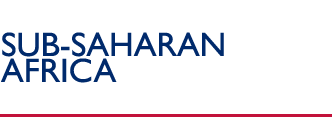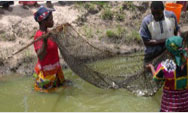Kenya
USAID's Strategy in Kenya
Though debilitated by decades of poor governance and lack of
investment, Kenya’s economy is still the largest and most
diversified in the region. At the end of 2002, peaceful and
democratic elections brought to power an opposition coalition,
the first government not led by the party that had governed
Kenya since independence. The new administration promised to
focus on economic growth, combat corruption, improve education,
and pursue judicial and political reforms. There is, however,
mounting concern that the new government is moving too slowly
on reforms. Current USAID programs focus on governance, sustainable
use of natural resources, agriculture, economic growth, health,
and education.
IMPROVING INSTITUTIONS OF GOVERNANCE
Although an important democratic transition occurred in 2002,
the governing coalition is fragile and its emphasis has been
more on power sharing arrangements than comprehensive democratic
reforms. USAID continues to promote transparent and accountable
governance by improving the balance of power among the various
branches of government and increasing the effectiveness of institutions
including the Parliament, the electoral commission, the Department
of Public Prosecutions, and civil society organizations.
PROMOTING SUSTAINABLE USE OF NATURAL RESOURCES
Limited job opportunities have contributed to the majority
of Kenyans becoming exceedingly dependent on natural resources.
In response, USAID helps communities manage their resources
more sustainably. The program focuses on improving community-based
wildlife management, strengthening forestry and environmental
management, and enhancing integrated coastal zone management.
Strengthening the skills of community-based organizations has
led to 770,000 hectares being put under improved management,
$652,000 in revenues from nature-based enterprises, and creation
of 1,200 new jobs. In addition, Parliament is acting on a land
policy review process and a forestry and wildlife bill, and
has already enacted an environmental bill.
INCREASING RURAL INCOMES
Farming is the primary source of income for 80 percent of rural
Kenyans. However, per capita annual income has declined every
year from $378 in 1992 to $360 in 2003. To raise rural incomes,
USAID supports expansion of horticulture, maize and dairy farming
for poor rural farmers, and increases their ability to access
credit and business services. USAID also provides support to
government policies that favor small-scale farmers. A combination
of drought-tolerant farming techniques and direct food distribution
is provided in arid and semi arid areas to decrease vulnerability.
In 2004, incomes in USAID targeted areas increased by 24 percent
compared to 12 percent in nonUSAID areas.
IMPROVING HEALTH CONDITIONS
HIV prevalence is declining, but there are still about 1.4
million HIV-positive Kenyans. The fertility decline has recently
stalled, the first reversal in this successful family planning
program, and child mortality rates are increasing, reversing
a long downward trend. USAID's health program focuses on reducing
fertility and the risk of HIV/AIDS through efforts to reform
the health care sector; prevent HIV transmission; provide treatment,
care, and support for those already infected; and deliver family
planning and child survival services.
SUPPORTING EDUCATION FOR MARGINALIZED PEOPLE
The high costs of schooling have kept poorer segments of Kenya’s
population out of the school systems. USAID’s basic education
program is focused on improving the quality and efficiency of
education for these historically marginalized populations, primarily
in the largely Muslim populations of the Northeastern and Coast
Provinces, which have the lowest rates of school enrollment
in Kenya. Key components of the USAID program include increasing
the appreciation for education and creating a demand for quality
educational services; encouraging the participation of marginalized
populations within the national education system; and improving
teacher practices through in-service training. Nearly 6,000
teachers will receive in-service training, and 350 teachers
will be trained in interactive radio instruction.
Back to Top ^
|


